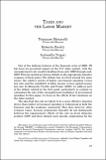Mostrar el registro sencillo del ítem
Taxes and the labor market
| dc.contributor.author | Monacelli, Tommaso | |
| dc.contributor.author | Perotti, Roberto | |
| dc.contributor.author | Trigari, Antonella | |
| dc.coverage.spatial | ESTADOS UNIDOS | es_ES |
| dc.date.accessioned | 2019-11-01T00:05:55Z | |
| dc.date.available | 2019-11-01T00:05:55Z | |
| dc.date.issued | 2013 | |
| dc.identifier.isbn | 978-956-7421-37-4 | |
| dc.identifier.uri | https://hdl.handle.net/20.500.12580/3888 | |
| dc.description | One of the defining features of the financial crisis of 2008?09 has been its persistent impact on the U.S. labor market with the unemployment rate roughly doubling from early 2008 through mid2010. This has ignited an intense debate on the appropriate stimulus response of fiscal policy. The debate has revolved around two main issues: the relative merits of higher government spending versus tax cuts and the suitability of labor income versus capital income tax cuts. In Monacelli Perotti and Trigari (2010) we address part of the debate related to the first point particularly in relation to estimating the size of the unemployment multiplier of government spending. In this paper we focus on the effects of tax variations on the labor market. | |
| dc.format | ||
| dc.format.extent | Sección o Parte de un Documento | |
| dc.format.medium | p. 27-58 | |
| dc.language.iso | eng | |
| dc.publisher | Banco Central de Chile | |
| dc.relation.ispartof | Series on Central Banking Analysis and Economic Policies no. 17 | |
| dc.rights | Attribution-NonCommercial-NoDerivs 3.0 Chile | * |
| dc.rights.uri | http://creativecommons.org/licenses/by-nc-nd/3.0/cl/ | * |
| dc.subject | TRIBUTACIÓN | es_ES |
| dc.subject | MERCADO LABORAL | es_ES |
| dc.subject | CRISIS ECONÓMICA 2008 | es_ES |
| dc.subject | DESEMPLEO | es_ES |
| dc.subject | POLÍTICA FISCAL | es_ES |
| dc.title | Taxes and the labor market | |
| dc.type.doc | Artículo | |
| dc.file.name | BCCh-sbc-v17-p027_058 |


